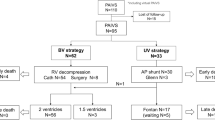Summary
Limited information is available concerning the long-term survival of patients with atrioventricular discordance, ventriculoarterial discordance, and two ventricles (corrected transposition). The long-term follow-up of 107 patients examined at the Mayo Clinic over a 30-year period between 1951 and 1981 was reviewed. Overall survival from the date of Mayo Clinic diagnosis was 70% at five years and 64% at ten years. Associated variables were analyzed for their effect on survival including sex, age at diagnosis, presence of ventricular septal defect, pulmonary stenosis, dextrocardia, left atrioventricular valve insufficiency, and complete heart block.
There was no significant difference between those with and without a ventricular septal defect (VSD). Pulmonary stenosis was protective when a VSD was present but was not a significant predictor of long-term survival. The only variable that consistently correlated with decreased survival was left atrioventricular valve insufficiency (p<0.04 for univariate and stepwise Cox, andp=0.08 for multivariate analysis). A logistic model for survival after open-heart surgery failed to identify any significant variable.
We conclude that the presence of left atrioventricular valve insufficiency in association with atrioventricular discordance significantly alters the long-term outcome. Atrioventricular valve replacement should be considered in such patients when insufficiency becomes hemodynamically significant.
Similar content being viewed by others
References
Berman DA, Adicoff A (1969) Corrected transposition of the great arteries causing complete heart block in an adult.Am J Cardiol 24:125–129
Bjarke BB, Kidd BSL (1976) Congenitally corrected transposition of the great arteris.Acta Paediatr Scand 65:153–160
Cox DR (1972) Regression models and life-tables [with discussion].J R Stat Soc [B] 34:187–220
Friedberg DZ, Nadas AS (1970) Clinical profiles of patients with congenital corrected transposition of the great arteries.N Engl J Med 282:1053–1059
Huhta JC, Maloney JD, Ritter DG, Ilstrup DM, Feldt RH (1983) Complete atrioventricular block in patients with atrioventricular discordance.Circulation 67:1374–1377
Kaplan EL, Meier P (1958) Non-parametric estimation from incomplete observations.J Am Stat Assoc 53:457–481
Lieberson AD, Schumacher RR, Childress RH, Genovese PD (1969) Corrected transposition of the great vessels in a 73-year-old man.Circulation 39:96–100
Author information
Authors and Affiliations
Additional information
J.C.H. is the recipient of New Investigator Research Award HL31153 from the National Institutes of Health United States Public Health Service.
Rights and permissions
About this article
Cite this article
Huhta, J.C., Danielson, G.K., Ritter, D.G. et al. Survival in atrioventricular discordance. Pediatr Cardiol 6, 57–60 (1985). https://doi.org/10.1007/BF02282738
Issue Date:
DOI: https://doi.org/10.1007/BF02282738




